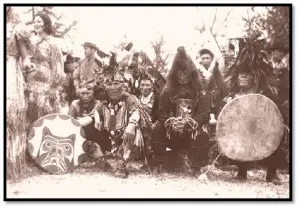The Coast Salish Tribe were Native American people in British Columbia, Washington, and Oregon who speak either one of the Salishan language family’s numerous languages or dialects. The Coasts Salish is a cultural or ethnography divided into three regional designations: North Coastal, Central, and South Coastal.
The Coast Salish homeland covers most of the Strait of Georgia-Puget Sound Basin, including the sites of the modern-day cities of Vancouver, British Columbia, Seattle, Washington, and others. Simply put, The Coasts Salish occupied a large portion of the present-day United States. Also see here the history of Salish Trible
Coast Salish Religion
These areas are divided into regions designated as north, central, and southern coastal. Archaeologists indicate some evidence that the Coast Salish may have lived in the area as far back as 9000 B.C.E. The area of what is now Seattle has been inhabited by this group ever since the end of the last glacial period.
Throughout their existence, a lot of the Coast Salish people have depended on fishing as the mainstay of their culture and their survival. They designed the commonly utilized fishing techniques of the reef net, the purse seine, and the weir, and lived in settlements along the mainland San Juan Islands. Ceremonies related to the salmon and salmon fishing have been passed down through generations that would provide evidence of these people’s existence.

Cultures of the Coast Salish
Religion
The three regions of The Coast Salish shared very similar religious myths, beliefs, and ceremonies. The class system of wealthy families holds the keys to the religious beliefs and practices, which was the foundation of the Salish society. Ceremonies were very popular.Beliefs in guardian spirits and metamorphosis between human and animal were widely shared in multiple versions. The relationship between souls, the lands of the living and the dead, were some of their beliefs. Quests and journeys involving other states of consciousness were varied and popularly practiced. The neighboring Duwamish tribe, for instance, practices a soul recovery ceremony.
Architecture
Villages and settlements of the Coast Salish people consisted of Western Red Cedar split plank and earthen floor longhouses that can house 40 or more people.
Also used by many villages were pit-houses, known in the Chinook Jargon as Kekuli. A reconstruction of such an underground shelter can be seen by the public besides the Lillooet Tribal Council’s offices near the reserve community of T’t’ikt in Lillooet, British Columbia. Its design is based heavily on the notes drawn by anthropologist James Teit from interviews with a St’at’imc (Salish) woman.
Art
Artwork by the Coast Salish people is found in a variety of forms. They were very good at carving and painting in a unique style depicting animals, birds, fish, humans, mythical figures, and spirit beings.
The use of crimson, black and other colors depicting negative and positive proportions gives their artistic style a unique quality. They also make masks of mythical beings range from small to extremely enormous. Good examples can be seen at the famous Burke Museum at the University of Washington in Seattle.
